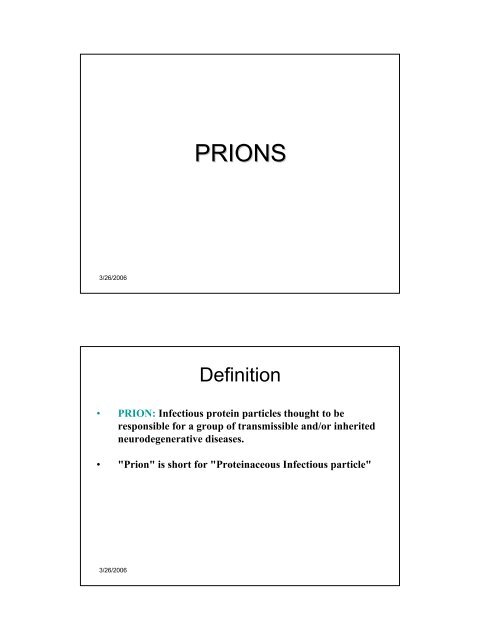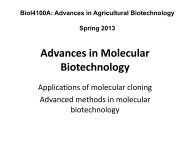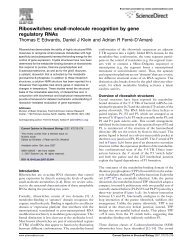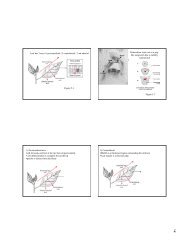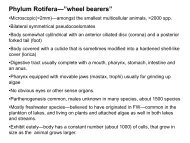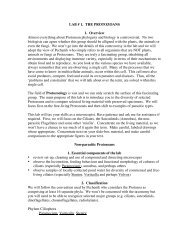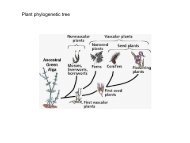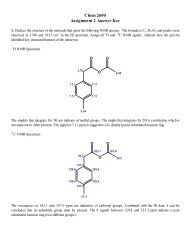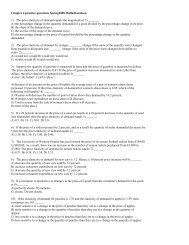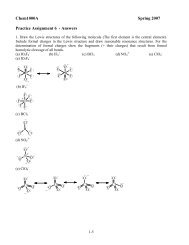Handout 9 - Prions
Handout 9 - Prions
Handout 9 - Prions
You also want an ePaper? Increase the reach of your titles
YUMPU automatically turns print PDFs into web optimized ePapers that Google loves.
3/26/2006<br />
3/26/2006<br />
PRIONS<br />
Definition<br />
• PRION: Infectious protein particles thought to be<br />
responsible for a group of transmissible and/or inherited<br />
neurodegenerative diseases.<br />
• "Prion" is short for "Proteinaceous Infectious particle"
Structure<br />
<strong>Prions</strong> are infectious agents composed exclusively of a<br />
single sialoglycoprotein called PrP 27-30.<br />
They contain no nucleic acid.<br />
PrP 27-30 has a mass of 27,000 - 30,000 daltons and is<br />
composed of 145 amino acids with glycosylation at or near<br />
amino acids 181 and 197.<br />
This protein polymerizes into rods possessing the<br />
ultrastructural and histochemical characteristics of amyloid.<br />
3/26/2006<br />
Humans diseases<br />
• Evidence suggests that a prion is a modified form of a<br />
normal cellular protein known as PrPc (for cellular), a<br />
single copy gene.<br />
• This protein is found predominantly on the surface of<br />
neurons attached by a glycoinositol phospholipid anchor,<br />
and is protease sensitive. Thought to be involved in<br />
synaptic function.<br />
3/26/2006
Humans diseases<br />
• The modified form of PrPc which may cause disease i.e.<br />
the prion is known as PrPsc (for scrapie) which is<br />
relatively resistant to proteases and accumulates in<br />
cytoplasmic vesicles of diseased individuals.<br />
• It has been proposed that PrPsc when introduced into a<br />
normal cell causes the conversion of PrPc into PrPsc.<br />
Process is unknown but it could involve a chemical or<br />
conformational modification.<br />
3/26/2006<br />
Humans diseases<br />
• PrPc serves a function that is not apparent in a<br />
laboratory setting<br />
• Current possibilities involve shuttling or sequestration<br />
of synaptic Cu(II) via binding to N-terminal octapeptide<br />
residues and/or signal transduction involving the fyn<br />
kinase.<br />
3/26/2006
3/26/2006<br />
Replication<br />
The prion is a product of a human gene, termed the PrP<br />
gene, found on chromosome 20.<br />
This gene contains two exons separated by a single intron.<br />
Exon I and Exon II are transcribed and the two RNAs ligated<br />
into a single mRNA.<br />
This mRNA contains an open reading frame (ORF) or protein<br />
coding region which is translated into the PrP protein.<br />
The PrP protein is a precursor of the prion protein. It is<br />
termed PrP 33-35.<br />
3/26/2006<br />
Replication<br />
The PrP 33-35 undergoes several post-translational events to<br />
become the prion protein (PrP 27-30):<br />
1. Glycosylation - at two sites.<br />
2. Formation of a disulfide bond between two cysteine<br />
residues.<br />
3. Removal of the N-terminal signal peptide.<br />
4. Removal of the C-terminal hydrophobic segment.<br />
5. Addition of a phosphatidylinositol glycolipid at the Cterminal.<br />
6. Removal of the N-terminal first 57 amino acids.
3/26/2006<br />
Replication<br />
In normal cells only the PrP 33-35 protein is synthesized.<br />
It is found in the neural cell membrane where it's function is<br />
to sequester Cu++ ions.<br />
In abnormal ("infected") cells, the PrP 27-30 is produced from<br />
the PrP 33-35 protein.<br />
3/26/2006<br />
Replication<br />
The PrP 27-30 triggers a series of reactions that produce<br />
more PrP 27-30 proteins, i.e., PrP 27-30 induces its own<br />
synthesis.<br />
In addition to the post translational modifications, the PrP 27-<br />
30 protein differs from the PrP 33-35 protein in a single<br />
amino acid residue.<br />
Residue 178 in the PrP 27-30 contains an asparagine<br />
residue whereas the PrP 33-35 protein has an aspartate<br />
residue at this position.
3/26/2006<br />
Replication<br />
This causes a conformational change in the PrP 27-30<br />
protein from an α-helix to a β-sheet. This conformational<br />
change in the PrP 27-30 protein has three effects:<br />
1. It imparts to the PrP 27-30 protein the ability to induce<br />
the same α -helix to β -sheet conformation in the PrP 33-35<br />
protein. This is a permanent conformational change. It thus<br />
induces its own "replication."<br />
2. The β-sheet-forming peptides aggregate to form amyloid<br />
fibrils.<br />
3. The amyloid fibrils kill thalamus neurons through<br />
apoptosis.<br />
Pathologies induced by prions<br />
All diseases known to be of prion etiology, in animals and<br />
humans, are neurodegenerative diseases. In the human this<br />
includes:<br />
•Creutzfeldt-Jakob disease (CJD)<br />
•Fatal Familial Insomnia<br />
•Gerstmann-Straussler syndrome<br />
•Kuru<br />
3/26/2006
Pathologies induced by prions<br />
The pathological and clinical signs of these diseases suggest<br />
that they are closely related.<br />
In fact they may be variants of the same disorder.<br />
All pathological features are confined to the central nervous<br />
system.<br />
The prion protein accumulates selectively and abnormally in<br />
CNS nerve cells during the course of the disease.<br />
3/26/2006<br />
Pathologies induced by prions<br />
PrP 27-30 accumulates within the neuronal system where it<br />
causes:<br />
1. Astrocyte gliosis (an increase in the number of<br />
astrocytes).<br />
2. Depletion of dendritic spines in neurons.<br />
3. Formation of numerous vacuoles in the cerebellar cortex<br />
(spongiform encephalopathy).<br />
3/26/2006
Pathologies induced by prions<br />
4. Amyloidosis - deposition of amyloid in the cerebellar<br />
cortex, thalamus, brain stem and in the lumen of blood<br />
vessels within the brain.<br />
These amyloid plaques consist of discrete eosinophilic<br />
glassy-appearing masses, often having radiating amyloid<br />
fibrils at their periphery.<br />
The plaques are primarily subependymal, subpial and<br />
perivascular.<br />
3/26/2006<br />
Pathologies induced by prions<br />
Note that the pathology does NOT include any signs of<br />
inflammation or fever.<br />
This is evidence that the immune system does not respond to<br />
the prion protein.<br />
Since the prion protein is derived from self this is what you<br />
would expect.<br />
These pathologies give rise to the clinical symptomology<br />
seen in these patients.<br />
3/26/2006
Pathologies induced by prions<br />
These are:<br />
1. A long incubation period (several years) which has given<br />
rise to the term "slow infection."<br />
2. Loss of muscle coordination which leads to a difficulty in<br />
walking, indicating a functional disorder of the cerebellum.<br />
3. Dementia characterized initially by loss of memory,<br />
diminished intellect and poor judgment.<br />
4. Progressive insomnia characterized by a marked<br />
reduction or loss of the slow-wave and rapid-eye-movement<br />
phases.<br />
3/26/2006<br />
3/26/2006<br />
Transmission<br />
Spread of the disease is via horizontal transmission, i.e.,<br />
transmission from one person to another, either directly or<br />
by ingestion of contaminated meat.
Diagnosis<br />
In the past, diagnosis of prion disease was made through<br />
examination of brain biopsies taken from patients in<br />
advanced stages of the disease or, more commonly, after<br />
they had died.<br />
In January of 1999 it was found that the prion protein<br />
accumulated in the tonsils and could be detected by an<br />
immunofluorescence test on tonsilar biopsies.<br />
3/26/2006<br />
3/26/2006<br />
Diagnosis<br />
A second test was simultaneously developed which was<br />
based on a Western blot.<br />
Later that year a third test was developed that had the high<br />
sensitivity necessary to detect the prion protein in blood.<br />
This test is based on capillary electrophoresis with laserinduced<br />
fluorescence. It detects as little as 10 -18 mole.
3/26/2006<br />
Prion Diseases<br />
Prion diseases are often called spongiform encephalopathies<br />
because of the post mortem appearance of the brain with<br />
large vacuoles in the cortex and cerebellum.<br />
Probably most mammalian species develop these diseases.<br />
Specific examples include:<br />
•Scrapie: sheep<br />
•TME (transmissible mink encephalopathy): mink<br />
•CWD (chronic wasting disease): muledeer, elk<br />
•BSE (bovine spongiform encephalopathy): cows<br />
Humans are also susceptible<br />
to several prion diseases:<br />
•CJD: Creutzfeld-Jacob Disease<br />
•GSS: Gerstmann-Straussler-Scheinker syndrome<br />
•FFI: Fatal familial Insomnia<br />
•Kuru<br />
•Alpers Syndrome<br />
3/26/2006
Humans are also susceptible<br />
to several prion diseases:<br />
•The incidence of sporadic CJD is about 1 per million per<br />
year.<br />
•GSS occurs at about 2% of the rate of CJD.<br />
•It is estimated that 1 in 10,000 people are infected with CJD<br />
at the time of death.<br />
These figures are likely to be underestimates since prion<br />
diseases may be misdiagnosed as other neurological<br />
disorders.<br />
3/26/2006<br />
Humans are also susceptible<br />
to several prion diseases:<br />
•The diseases are characterized by loss of motor control,<br />
dementia, paralysis wasting and eventually death,<br />
typically following pneumonia.<br />
• Fatal Familial Insomnia presents with an untreatable<br />
insomnia and dysautonomia. Details of pathogenesis are<br />
largely unknown.<br />
•Visible end results at post-mortem are non-inflammatory<br />
lesions, vacuoles, amyloid protein deposits and<br />
astrogliosis.<br />
3/26/2006
Humans are also susceptible<br />
to several prion diseases:<br />
•GSS is distinct from CJD, it occurs typically in the 4th-5th<br />
decade, characterized by cerebellar ataxia and concomitant<br />
motor problems, and less common dementia.<br />
•(Originally thought to be familial, but now known to occur<br />
sporadically as well).<br />
3/26/2006<br />
Humans are also susceptible<br />
to several prion diseases:<br />
•CJD typically occurs a decade later has cerebral<br />
involvement so dementia is more common and patient<br />
seldom survives a year (originally thought to be sporadic, but<br />
now known to be familial as well).<br />
•FFI pathology is characterized by severe selective atrophy of<br />
the thalamus.<br />
Alpers syndrome is the name given to prion diseases in<br />
infants.<br />
3/26/2006
Humans diseases<br />
• Kuru is the condition which first brought prion diseases to<br />
prominence in the 1950s. Found in geographically isolated<br />
tribes in the Fore highlands of New Guinea.<br />
• Established that ingesting brain tissue of dead relatives for<br />
religious reasons was likely to be the route of transmission.<br />
They ground up the brain into a pale grey soup, heated it and<br />
ate it.<br />
• Clinically, the disease resembles CJD. Other tribes in the<br />
vicinity with same religious habit did not develop the disease. It<br />
is speculated that at some point in the past a tribe member<br />
developed CJD, and as brain tissue is highly infectious this<br />
allowed the disease to spread. Afflicted tribes were encouraged<br />
not to ingest brain tissue and the incidence of disease rapidly<br />
declined and is now almost unknown.<br />
3/26/2006<br />
Humans might be infected by<br />
prions in 2 ways:<br />
1. Acquired infection (diet and following medical procedures<br />
such as surgery, growth hormone injections, corneal<br />
transplants) i.e. infectious agent implicated.<br />
2. Apparent hereditary Mendelian transmission - where it is<br />
an autosomal and dominant trait. This is not consistent<br />
with an infectious agent.<br />
3/26/2006
Humans might be infected by<br />
prions in 2 ways:<br />
• This is one of the features that single out prion diseases<br />
for particular attention.<br />
• They are both infectious and hereditary diseases.<br />
• They are also sporadic, in the sense that there are also<br />
cases in which there is no known risk factor although it<br />
seems likely that infection was acquired in one of the two<br />
ways listed above.<br />
3/26/2006<br />
Prion diseases:<br />
•Scrapie was the first example of this type of disease to be<br />
noticed and has been known about for many hundreds of<br />
years.<br />
•There are two possible methods of transmission in sheep:<br />
1. Infection of pasture with placental tissue carrying the<br />
agent followed by ingestion,or direct sheep-lamb<br />
transmission i.e. an acquired infection.<br />
2. Parry showed considerable foresight by suggesting that<br />
it is not normally an infectious disease at all but a genetic<br />
disorder. He further suggested that selective breeding<br />
would get rid of the disease.<br />
3/26/2006
Several lines of evidence support protein only<br />
model of infection:<br />
1. Nucleic acid is not necessary for infectivity:<br />
• failure to identify a scrapie specific nucleic acid either in prion<br />
preparations or infected brains using a variety of sophisticated<br />
techniques.<br />
• unusually small target size for ultraviolet and ionizing radiation:<br />
• the low ratio of nucleic acid to infectious material.<br />
• resistance of infectivity to agents which modify or damage nucleic<br />
acids but infectivity is susceptible to reagents which destroy proteins:<br />
3/26/2006<br />
Stabilities of the scrapie agent and viriods (PSTV):<br />
3/26/2006<br />
•Chemical Treatment: •Concentration •PSTV •Scrapie<br />
•Et2PC •10-20mM •(-) •+<br />
•NH2OH •0.1-0.5mM •+ •-<br />
•Psoralen •10-500µg/ml •+ •-<br />
•Phenol •Saturated •- •+<br />
•SDS •1-10% •- •+<br />
•Zn2+ •2mM •+ •-<br />
•Urea •3-8M •- •+<br />
•Alkali •pH 10 •(-) •+<br />
•KSCN •1M •- •+<br />
•Enzymatic Treatment: •Concentration •PSTV •Scrapie<br />
•RNAse A •0.1-100µg/ml •+ •-<br />
•DNAse •100µg/ml •- •-<br />
•Proteinase K •100µg/ml •- •+<br />
•Trypsin •100µg/ml •- •+
2. PrPsc is associated with scrapie infectivity:<br />
•purification of scrapie infectivity results in preparations<br />
highly enriched for PrPsc<br />
•purification of PrPsc results in enrichment of scrapie<br />
activity<br />
•purification of PrPsc by SDS-PAGE also recovers<br />
infectivity<br />
•PrPsc can be denatured and renatured without loss of<br />
infectivity<br />
3/26/2006<br />
3. Susceptibility of a host to prion infection is codetermined<br />
by the prion inoculum and the PrP gene:<br />
•disease incubation time for a single prion isolate varies<br />
between mouse strains,<br />
•this variation depends on the PrP gene,<br />
•suggesting some forms of PrPc may be more easily<br />
converted to PrPsc than others.<br />
3/26/2006
3. Susceptibility of a host to prion infection is codetermined<br />
by the prion inoculum and the PrP gene:<br />
•when prions are transmitted from one species to another<br />
disease develops only after a very long incubation period, if<br />
at all, but on serial passage in the new species the incubation<br />
time often decreases dramatically and then stabilizes.<br />
This species barrier can be overcome by introducing a PrP<br />
transgene from the prion donor i.e. hamster PrPc but not<br />
murine PrPc is a suitable substrate for conversion to hamster<br />
PrPsc by hamster prions and vice versa:<br />
3/26/2006<br />
p y p<br />
is co-determined by the prion inoculum<br />
and the PrP gene:<br />
3/26/2006
4. Mutated gene can cause susceptibility<br />
to disease without apparent infection:<br />
•Homozygosity at the polymorphic amino acid position 129 of PrP<br />
protein predisposes an individual to acquired and sporadic CJD<br />
•2 unrelated GSS families have the same double mutation i.e. 178<br />
D-N; 200 E-K<br />
•disease tightly linked to a P-L mutation at 102 in some familial<br />
GSS cases<br />
•100 controls did not have this mutation nor did another 15<br />
sporadic victims of CJD<br />
•other familial cases have been shown to carry this or several<br />
other mutations e.g. 117-A-V; 198 F-S; N178; V129 = CJD; N178<br />
M129 = FFI<br />
3/26/2006<br />
3/26/2006<br />
4. Mutated gene can cause susceptibility to<br />
disease without apparent infection:<br />
•One possibility, the genetic explanation, was that these<br />
mutations enhance the rate of spontaneous conversion of<br />
PrPc to PrPsc which permits disease manifestation within the<br />
lifetime of an individual.<br />
Suggests that some sporadic incidents can be accounted for<br />
by somatic mutation of the PrP gene.<br />
An alternative explanation is that these mutations confer<br />
susceptibility to infection
3/26/2006<br />
5. Crucial experiment:<br />
•Mice carrying a murine transgene with the 102P-L GSS<br />
mutation spontaneously develop a lethal scrapie like disease.<br />
Brains also contain infectious prions because transmission to<br />
recipient animals has been demonstrated.<br />
Mice lacking the PrPc gene develop normally, no evident<br />
physiological or behavioural problems.<br />
Suggests that loss of PrPc function is unlikely to be the<br />
cause of disease rather accumulation of PrPsc is<br />
responsible.<br />
3/26/2006<br />
5. Crucial experiment:<br />
When inoculated with prions they do not develop disease.<br />
There are obvious implications here for the livestock and<br />
pharmaceutical industries and treatment of familial cases.<br />
Animals expressing reduced levels of PrPc are also resistant<br />
to infection - perhaps more immediately relevant to human<br />
disease.<br />
Animals overexpressing PrPc are more likely to develop<br />
prion diseases.
3/26/2006<br />
Evidence against the prion model:<br />
•The existence of many different strains of scrapie (at least<br />
15: latency, lesion patterns differ) which can be propagated<br />
in the same inbred mouse strain.<br />
These can transmit serially without changes in properties in<br />
the same mouse strain homozygous for a single PrP<br />
genotype.<br />
Cannot argue that there a distinct PrPc is converted to<br />
distinct PrPsc.<br />
Must mean that a common PrPc is corrupted in a different<br />
way, seems improbable but there is now experimental<br />
support for it.<br />
So how can a protein be infectious?<br />
A likely possibility is that the difference between PrPc and<br />
PrPsc is conformational.<br />
It is proposed therefore that this protein can adopt two quite<br />
different stable conformations.<br />
The safe PrPc form is normally adopted but rarely it can<br />
switch to the PrPsc form.<br />
Mutations favour this switch.<br />
It is proposed that PrPsc is transdominant and converts<br />
PrPc to PrPsc in an exponential fashion.<br />
3/26/2006
The structure of part of the hamster and mouse<br />
PrPc molecules superimposed<br />
3/26/2006<br />
The position of various mutations important for<br />
prion disease development in humans.<br />
Many of these mutations are positioned such that they<br />
could disrupt the secondary structure of the molecule.<br />
3/26/2006
Treatment<br />
•PrPc overexpression facilitates the development of prion<br />
diseases.<br />
It may therefore follow that agents which reduce PrPc<br />
expression will delay the onset of prion diseases.<br />
One can speculate that chemicals which bind to and stabilize<br />
the PrPc conformation may be beneficial.<br />
Similarly agents destabilizing the PrPsc conformation may be<br />
effective. In this regard several vaccines to Alzheimers<br />
amyloid plaques are in clinical trials.<br />
Agents which interfere with the putative PrPc-PrPsc<br />
interaction might similarly be effective.<br />
3/26/2006<br />
3/26/2006<br />
Treatment<br />
•A number of reagents showing affinity for amyloid proteins<br />
are known e.g congo red.<br />
As our knowledge of the structure of PrPc increases, the<br />
chances of rationally deducing effective therapeutics based<br />
on these ideas increases.
3/26/2006<br />
Treatment<br />
•Finally we have seen that PrPc expression is required for<br />
pathology.<br />
Chemicals affecting the endocytosis, exocytosis, intracellular<br />
trafficking and degradation of proteins and in particular PrPc<br />
may also be effective.<br />
Amphotericin for instance is reported to delay prion disease<br />
in hamsters (although it apparently has little effect in<br />
humans).<br />
• References:<br />
<strong>Prions</strong>.http://www.cartage.org.lb/en/themes/<br />
Sciences/LifeScience/GeneralBiology/Micr<br />
obiology/<strong>Prions</strong>Viroids/<strong>Prions</strong>/<strong>Prions</strong>.htm<br />
3/26/2006


